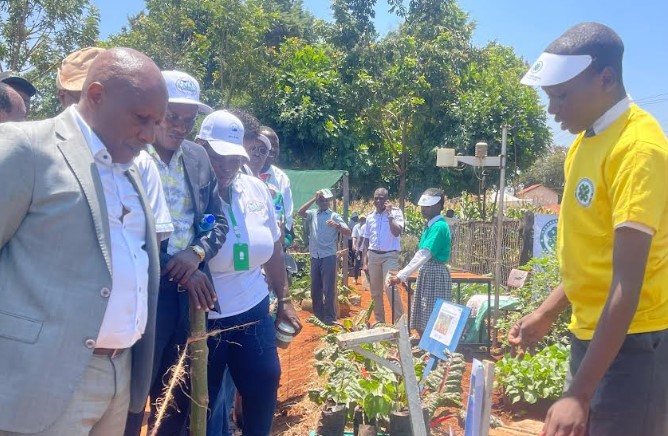The Kenya Agricultural and Livestock Research Organization (KALRO) Open Week exhibition, slated to run throughout the month of March, is expected to showcase the latest breakthroughs in crop and livestock development.
The Exhibitions will feature cutting-edge agricultural innovations, field demonstrations of improved farming techniques, expert discussions on key agricultural challenges and opportunities, and engagements with policymakers, researchers, and private sector stakeholders to foster collaboration and knowledge exchange in the agricultural sector.
Speaking at the KALRO Kabete in Nairobi during the official launch, the National chairman of KALRO, Dr. Thuo Mathenge, said as a research institute they are committed to advancing food security, climate resilience, and economic growth through innovative research.

“This event will showcase KALRO’s latest breakthroughs in crop and livestock development, sustainable farming technologies, and climate-smart agricultural solutions”, he noted
The chairman said that soon they will engage over 200 young people from each County in planting sunflowers and that the government is ready to allocate around 400 acres of land in this initiative.
“We will engage the youth through cooperatives and connect them with the Youth Fund, with the Agriculture Finance Corporation (AFC), and with the Hustlers Fund. We want them to know about agriculture; show them that agriculture can be good business and that they can make money in it,” Dr. Mathenge added.
He emphasized that the government has now got land, resources and scientists to ensure the growth of the sunflower plant is materialized.
Dr. Mathenge went on to explain that once the youth grow the crop, the government is going to organise and buy oil pressing machines and refinery so that they can make oil and this, he noted, will reduce the importation of oil from outside the country that costs billions of shillings.
The chairman explained that apart from KALRO, there are other government institutions that have idle lands that, as an institution, will ensure boreholes and also provide expertise.
This, Dr. Mathenge, will be done by May, noting that they have already started the preparatory work and that next month in April they will have engaged young people who are interested in farming, those who have done agriculture courses, accountants and even mechanics since their expertise combined and assisted by KALRO scientists will see the sunflower production kick off and thrive.
“We are starting with the sunflower; we want to make enough oil and stop Kenya from importing cooking oil but will be able to move other crops and value chains and this means creating jobs for over 10,000 youth”, Dr. Mathenge said.

Dr. Eliud Kireger, Director General KALRO, said if we can grow oil in Kenya, we can be able to reduce more than Sh 60 billion that has been going to other countries through importation.
“Our youth can utilize this kind of money and we would like to introduce sunflower growth even at the homestead level, just like it was in the 1970s when sunflower production was done but fizzled out due to lack of market,” he added.
He noted that Kenya has its own varieties and focus currently because of climate change are those that are drought tolerant, because that is the biggest challenge.
Kenya boasts of about 14 varieties of sunflower seeds, has significant potential for sunflower cultivation, particularly for edible oil production, and currently produces about 80,000 metric tonnes but spends up to Sh117 billion annually for the importation of edible oil and this trend can be reversed through investment in sunflower farming.
Dr. Kireger explained that the KALRO exhibition week that runs every year across all KALRO centres engages farmers who are able to see the latest technologies and varieties that are available for them to plant and this includes a demo farm that shows them how to plant the crops.
During the exhibitions, he added that farmers are able to also purchase products such as the planting materials, especially now at this time when the rains are almost on and noted that there are over 400 crops that are ready for commercialization.
He gave an example of two new maize varieties dubbed “Ukame” that are drought-tolerant and another “Embu variety that is for low-land areas.
Dr. Kireger confirmed that they have several MOUs with Private Sector players in potatoes and even maize where they are producing for commercial purposes.
The DG further said that through exhibitions, some of the challenges of the extension services are also addressed as farmers are able to pick the new technologies in terms of crop variety, management, seeds, disease and pest control and learn from the experts and this he noted has been successful.
“For the four years running the field days, the numbers have been increasing; it’s an activity that farmers have been looking up to and this has also helped us as an institution as we gear towards creating employment, especially for the youth
Dr. Kireger called on farmers to be buying seeds from certified agents and agro vets, planting the right seeds and avoiding fake seeds because that will harm their production.
KALRO will be running the exhibitions throughout this month on diverse dates at their 17 centres across the country and farmers, stakeholders and the public are urged to visit any of them to learn about best practices driving the future of Kenya’s agriculture.
By Wangari Ndirangu





